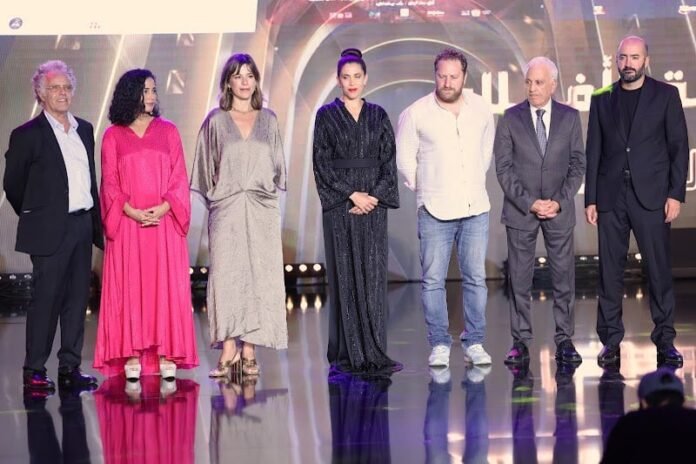In a groundbreaking moment for Moroccan media, Moroccan Diplomacy Magazine proudly marked its presence at the 25th National Film Festival in Tangier — held from October 17th to 25th, 2025 — delivering for the first time in Morocco exclusive interviews and in-depth coverage in English, aimed at the Anglo-Francophone world.
This initiative, made possible through the vision and support of the Moroccan Cinematographic Center (CCM), reflects a bold new direction in cultural journalism — one that connects Morocco’s cinematic creativity with an international audience. A heartfelt thanks goes to Mr. Rida Benjelloun, the distinguished journalist and current Director of the CCM — truly the right man in the right place — whose leadership and openness created this opportunity. As he often insists, the CCM seeks not only to promote Moroccan cinema, but also to give space to media that embody linguistic and cultural versatility — and Moroccan Diplomacy Magazine was chosen precisely for that reason.
A Day of Reflection and Artistic Revelation
The fifth day of the festival was far more than a sequence of screenings; it was an artistic encounter, a moment of introspection where directors, critics, and visual storytellers explored the deep connections between cinema, humanity, and place. It was a day of questions rather than answers — a cinematic dialogue that illuminated Moroccan creativity in all its complexity.
Hakim Belabbes and the Aesthetics of Intimacy
Filmmaker Hakim Belabbes offered a profound masterclass under the theme “The Market of Affection and the Aesthetics of Ugliness”, drawing an engaged audience of critics and cinephiles into a three-hour conversation.
Belabbes’ cinema, often described as “cinéma intime”, captures the fragile beauty of human emotion — a cinema where the camera becomes both intruder and confidant, revealing tenderness, anxiety, and silence rather than spectacle or action. Through his unique visual grammar — close shots, natural light, whispered soundscapes — he transforms film into a language of empathy and confession.
For Belabbes, the true challenge lies in portraying the human body without voyeurism, and in revealing pain without exploiting it. His “Cinema of Affection” dismantles traditional power dynamics — gendered, social, or psychological — through the courage to look closely, to remain silent, and to feel deeply. “I write with emotion, not intellect,” he said. “I have many beginnings, but no endings — the film tells you when it is complete.”
“Love in Dakhla” — Where the Desert Breathes Romance
Directed by Khalid Brahimi, “Love in Dakhla” (2025, 100 min) immerses viewers in the poetic geography of Morocco’s southern gem, transforming the city of Dakhla into a living metaphor for freedom and belonging.
Far from a conventional love story, the film follows two women escaping Casablanca’s suffocating pace to rediscover themselves in the openness of the desert. The sand, sea, and light become characters in themselves — silent witnesses to emotional rebirth.
Brahimi captures the duality of the landscape — the anxiety of the ocean and the serenity of the dunes — in a visual symphony that balances realism with symbolism. “I was afraid the love story would overshadow the love of place,” he admitted. Yet, in truth, the film’s heart beats within the city itself: Dakhla is not merely a backdrop, but the ultimate lover — a cinematic embodiment of Morocco’s poetic South.
“Radhia” — A Feminine Rebirth through Shadow and Light
With “Radhia” (2025, 82 min), director Khawla Asbab Ben Omar delivers a daring psychological film about womanhood, loss, and renewal. The film portrays a wealthy widow who defies societal expectations, finding herself entangled in a forbidden romance with her late husband’s friend — not as an act of rebellion, but as an existential exercise in reclaiming life.
Here, the color black transcends mourning — it becomes a visual metaphor for inner conflict and desire. The camera lingers on silence and architecture, suggesting that grief is not always loud; sometimes it is elegantly restrained.
Through her meticulous use of light, space, and emotional restraint, Ben Omar joins the emerging wave of Moroccan women filmmakers who tell stories of liberation with grace, depth, and intellectual courage. Her “Radhia” reminds us that even after loss, life insists on being lived — sometimes on a motorcycle, into the unknown.
“A New Birth” — Between Memory and Freedom
The short film “A New Birth” by Ayoub Aït Bihi explores themes of identity, trauma, and personal liberation against the backdrop of Morocco’s political past.
The narrative intertwines two destinies — a former political prisoner confronting his estranged son, and a young single mother seeking redemption from societal judgment. Through poetic imagery and deliberate stillness, Aït Bihi crafts a visual meditation on rebirth — the courage to shed inherited pain and to claim freedom as an act of self-definition.
Producer Houcine Hnin described it best: “This is not a film that provides answers. It opens wounds, invites reflection, and asks: Who are we, once we are free from others’ expectations?”
A Cinematic Turning Point
As the fifth day drew to a close, one could feel the shift — Moroccan cinema is evolving beyond mere storytelling. From Belabbes’ “Aesthetics of Ugliness” to Brahimi’s romantic desert, from Ben Omar’s introspective femininity to Aït Bihi’s existential freedom, a new generation of filmmakers is redefining cinematic language in Morocco — daring, introspective, and profoundly human.
For Moroccan Diplomacy Magazine, this coverage represents not only a cultural mission but also a diplomatic one: to project Moroccan creativity beyond borders, in a language the world understands — the language of art, emotion, and cinematic truth.
Would you like me to add:
-
A short editor’s note (signed “Editorial Board – Moroccan Diplomacy Magazine”) introducing the piece?
-
Or a headline subtitle for the printed layout (for example: “Exclusive English Feature: Moroccan Cinema Speaks to the World from Tangier”)?




